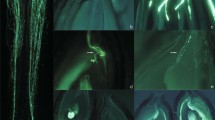Summary
The pollen of the Pelargonium, Salmon Fringed, and its Zonal bud sport can be classified into starch-filled, partly starchy, and starch-free.
In both cases the percentage of starch-filled reaches a maximum of about 93 per cent. in buds of 8 to 12 mm. length, then drops rapidly to about 15 per cent. in buds 15 mm. long. From this point on to anthesis the change is slower, reaching an equilibrium at about 20 mm.
The pollen of open flowers of Salmon Fringed has almost exactly twice (6.4-6.6 per cent.) the percentage of starch-filled pollen shown by its bud sport (3.3-3.8 per cent.). This is an expression of a difference in rate of starch digestion.
Temperatures of 25 and 30° C. hasten starch digestion, while 15° retards it. Behaviour at both extremes is erratic.
Analysis of pollen carbohydrate conditions for genetical purposes can perhaps be facilitated by the foregoing physiological considerations.
Similar content being viewed by others
References Cited
Parnell, F. R. (1921). “Note on the detection of segregation by examination of the pollen of rice,”Journ. Genetics, Vol. xi. pp. 209–212, Pl. XXI.
Demerec, M. (1924), “A case of pollen dimorphism in maize.”Amer. Journ. Bot. Vol. xi. pp. 461–464, Fig. 1.
Kiesselbach, T. A. andPeterson, N. F. (1925). “The occurrence of starch and erythrodexferin in maize and their segregation in the pollen of hybrids.”Genetics, Vol.x. pp. 86–89, PL I.
Bateson, W. (1921). “Root-cuttings and chimaeras. II.”Journ. Genetics, Vol. xi. pp. 91–96, Pls. XIII-XIV.
Renner, O. (1919). “Zur Biologie und Morphologie der männlichen Haplonten einiger Oenotheren.”Zeitschr. Bot. Bd. xr. S. 305–380.
Molisch, H. (1893). “Zur Physiologie des Pollens, mit besonderer Rücksicht auf die chemotropischen Bewegungen der Pollenschläuche.”Sitz. hais. Akad. Wiss. Wien, Math.-Nat. Cl. Bd. Cii, S. 1–26, T. I.
Lidforss, B. (1899). “Weitere Beiträge zur Biologie des Pollens,”Jahrb. wiss. Bot. Bd. xxxiii. S. 233–312.
Tischleb, G. (1909). “Untersuchungen Ueber den Stärkegehalt des Pollens tropischer Gewächse.”Jahrb. wiss. Bot. Bd. xlvii. S. 219–242.
Ferguson, N. (1924). “On the determination of the percentage of abortive pollen in plants.”Brit. Journ. Exp. Morph. Vol. ii. pp. 65–73, Tables i–vii.
Huxley, J. S. andFord, E. B. (1925). “Mendelian genes and rates of de-velopment.”Nature, Vol. cxvi. pp. 861–863.
Author information
Authors and Affiliations
Rights and permissions
About this article
Cite this article
Sears, P.B., Metcalf, E. The behaviour of pollen starch in a Geranium and its bud sport. Journ. of Gen. 17, 33–42 (1926). https://doi.org/10.1007/BF02983304
Issue Date:
DOI: https://doi.org/10.1007/BF02983304




